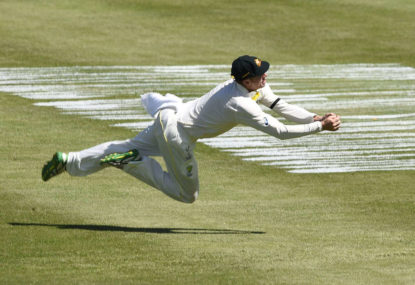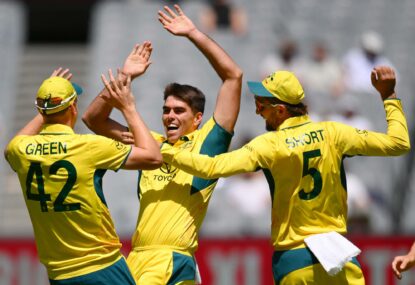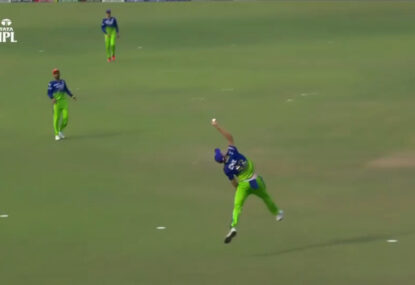It’s a broken record. The latest spin comes from Michael Holding asserting that “there’s too much lip service about the sanctity of Test cricket”.
There’s even a committed group of loyal fans bringing out a movie to support the cause. But what’s really going to save Test cricket?
Well, perhaps the record isn’t broken. Perhaps it’s the solution.
As a student of both the music industry and Test cricket, I’ve noticed that the rhetoric around the long-form game is similar to debates in the music business. The argument is often made in similar terms regarding quality and duration in cricket, or in music, the craft and the album.
What Twenty20 is to Test cricket, digital music services such as Spotify and Radio are to the physical albums. These services offer the same entertainment much quicker and with greater convenience.
For music consumers digital streaming services offer a universal library of music, typically listened to as single songs, rather than ‘long play’ album format.
Twenty20 also caters to greater expectations and lower attention spans. It is cricket as highlights, amazing catches, massive sixes (excuse me, DFL maximums) and flashing bails. Critically it lacks the subtlety, variety and the unique spirit of Test cricket. Tension doesn’t build, it rockets.
Test cricket and vinyl offer something different. They allow you to sit back and relax, watch or listen as the suspense unravels. As David Mitchell puts it:
“Sport is, in essence, the earliest and best form of reality TV (obviously it predates TV – before that, it was just “reality stuff you watch”). It’s compelling because it’s really happening and no one knows what the outcome will be, and whether it will be exciting and satisfying, a dull anti-climax, or maddeningly unjust.”
Vinyl is the same. It is intended to be consumed as a whole album, an entire experience, rather than the ‘highlights’ of the single song driven digital world. It’s also an investment, you pay for a physical artifact. Digital music is typically cheaper if not free.
The investment in Test cricket is time, five days or 40 hours. Twenty20 games can be all but a foregone conclusion in the first five overs, yet a Test match unravels with twists and turns each day.
There’s also the quality argument, as Mitchell waxes lyrically:
“Test cricket is just better: the batsmen have to make fewer mistakes, the bowlers are allowed their proper role as match-winners or losers, rather than run-savers, and, because a match lasts five days, it’s more exciting.”
To some, vinyl just sounds better, a “beautiful warm sound” to quote Lou Reed.
Many thought the post-Napster, or even post-CD vinyl music market, just like Test cricket, was doomed. And for a while it seemed so. But then something happened. A mind-numbingly simple idea – Record Store Day.
Launched in 2008 by a collection of independent record store owners, Record Store Day is one of the key reasons behind the vinyl revival. The most recent figures seem astounding; the US market increasing by 52 per cent between 2014 and 2013, the Australian market rising by over a 100 per cent.
However, it’s not as rosy as it appears.
Vinyl sales have only risen by such huge amounts because these sales had dipped so low. Vinyl sales represent two per cent of total recorded music sales. Additionally, the interests of major labels looking to monetise this revival threatens the passionate indie community that drove the revival.
Do we really need a vinyl reissue of A-Ha, or even worse, this Jay-Z-Linkin Park disaster? Should the money of ‘super fans’ actually willing to part with their cash go to the most powerful and popular releases? More importantly, in the long term, is this sustainable?
I don’t think so.
Record Store day is also built around the community, the music nerds. Those who regularly rack through record stacks and read liner notes – the ‘music enthusiasts’ that inhabit the pages of High Fidelity.
Test cricket needs to cater to cricket’s equivalent – the ‘cricket tragics’. (For example the long-suffering New Zealand Test cricket fans like myself.)
The only way to maintain the passion of these avid fans is to provide variety, not exhausting the big hits with endless Ashes series or series between the big boys, Australia, India and England. The quality of Test cricket is highest when more nations are competitive – the most recent New Zealand and England series are paramount examples.
It might even need the flair of new releases – new nations to play the real game, or a new sleeve, such as the day-night Test.
Twenty20 may be the future of the mass consumption of cricket, but what the vinyl revival shows is that passionate enthusiasts will still crave depth and this passion can be handed down the generations – 26 per cent of vinyl buyers are aged between 26 and 35.
It’s time for those in power to respect this passion and craft and take the more difficult yet sustainable road forward for Test cricket, rather than being petted like a dying cash cow, which needs to be milked rather than nourished.
That would be music to my ears.





































































































